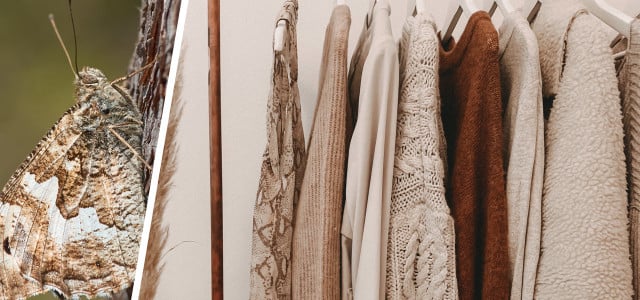We’ll show you how to get rid of clothes moths with your own homemade moth repellent. Here’s what you need to know.
Small, irregularly shaped holes dotting your clothing made of animal wool or other natural fibers are often proof that you may have a clothes moth problem. Utopia will show you how to identify clothes moths and how to get rid of these unwanted guests:
Preventative Measures: First Steps

If discovered, keep in mind that a clothes moth infestation is not due to a lack of hygiene or cleanliness.
Clothes moths, like other moth species, are attracted to light. For example, if you tend to keep the windows open at night during the summer months, these pesky pests can gain access to your cupboards or closet completely unobserved. Other times we may drag them in with newly purchased clothes – whether brand new from the mall or used from the secondhand shop.
There is no foolproof way to prevent moths from entering your home. But by taking a few preventive measures, you can at least make your closet or cupboard as uncomfortable a place for them as possible:
- Insect screens not only keep away mosquitoes, but also hungry moths – at least those that aren’t brought in as stowaways hidden in clothes.
- Wondering how to get rid of clothes moths? Moths like it dark and quiet. Tell them it’s time to go by wearing your clothes as often as possible and not hanging them too tightly in the closet.
- Be sure to vacuum wool carpets regularly.
If all these precautionary measures haven’t made a dent and you’re still wondering how to get rid of clothes moths, remember you don’t have to resort to chemical solutions just yet. Also consider: The chemical paradichlorobenzene commonly found in moth balls is not only harmful to your health but is also poorly biodegradable.
Here are some more sustainable moth repellents for you to consider.
How to Get Rid of Clothes Moths: DIY Moth Repellent



Here’s how to get rid of clothes moths with your own homemade all-natural moth repellents:
- Fragrances: Lavender is probably the best known homemade clothes moth repellent out there. Food moths also tend to shy away from intense odors. Essential oils are your best weapon: simply put a few drops of oil into hot water and clean the kitchen cupboards or the inside of your closet with it. Bags of dried lavender, thyme or sweet clover are very effective if you put them right into your basket of the clean laundry.
- Pure cotton and linen: Moths cannot digest and therefore tend to avoid both of these fabrics. It’s thus always a good idea to store expensive clothing in linen bags.
- Printer’s ink: Wrap seasonal clothing in newsprint when stored in boxes in the basement. This also tends to keeps moths away. Nobody really knows why – but it’s probably the ink.
- Real wool: Clothes moths love wool. If you suspect an infestation, put the piece of wool or wool fabric in a cardboard box and cut a one inch hole in the lid. Take the wool out once a week and boil it. This will destroy any eggs laid in the wool.
- Closed boxes: Regularly ventilate and check clothes stored in chests or boxes for moth infestations. Otherwise there will be a nasty surprise waiting for you in fall.
- Wash clothes regularly in hot water: Regularly wash above 120°F/50°C and you will also get rid of clothes moth larvae.
What Are Clothes Moths?
There are two types of clothes moths native to North America: the webbing clothes moth (Tineola bisselliella) and the casemaking clothes moth (Tinea pellionella). They are either beige or light to moderate yellow in color and narrow in shape. Their fringed wings have small hairs. No matter the species, adult moths won’t be the ones eating your sweater – the larvae they produce are the primary culprits.
The moths only feed on animal fibers. Their most common food sources are wool, fur, silk, feathers, felt and leather. These fibers all contain keratin, a fibrous protein that the moth larvae can digest. In the wild, these critters would otherwise be feeding on the nesting materials or remains of birds.
You can find out even more about clothes moths and how to get rid of them in this informative guide published by the University of Kentucky.
Utopia’s tip: Hand Washing Clothes: Tips and Tricks
This article was translated from German to English by Evan Binford. You can view the original here: Kleidermotten bekämpfen: Diese Hausmittel helfen dabei
Important Information regarding Health-related Topics.
** Links to retailers marked with ** or underlined orange are partially partner links: If you buy here, you actively support Utopia.org, because we will receive a small part of the sales proceeds. More info.Do you like this post?






